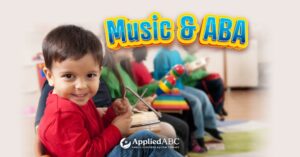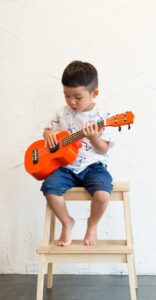
Music, A Universally Understood Language
Music is powerful. It can influence our emotions, attention, cognition, and more. Not only is it great entertainment, but we’ve found many therapeutic uses over the years:
-
A stimulus to better focus on work
-
A teaching tool to improve memorization
-
A motivator during physical therapy
Interacting with music – whether it’s listening, dancing, singing, or playing an instrument – addresses many domains of human development all at once. Since music is often enjoyed in group settings, it can help inspire a stronger sense of community and offer opportunities to practice social skills.
“Music is a more potent instrument than any other for education because rhythm and harmony find their way into the inward places of the soul.”
– Plato

From Nonverbal to Music Virtuoso
Tony DeBlois’ story is an incredible example of how music can enhance ABA therapy.
Tony was born blind and diagnosed with autism and savant syndrome at an early age. He was nonverbal and only communicated through gestures, and later, by playing the family piano.
At just two years old, Tony taught himself ‘Twinkle, Twinkle Little Star’ by ear. While in high school, his passion and skill for music expanded to over 20 instruments. He was able to sing in 11 different languages, yet Tony lacked cognitive skills and couldn’t brush his teeth or get dressed by himself.
His mother, Janice DeBlois, realized she could harness his passion to influence certain behaviors and apply the physical movements he used when creating music to general life skills.
For example, Tony learned how to brush his teeth by mimicking the motion of a violin stroke, one of his favorite instruments. Each time he successfully mirrored the desired motion, he was rewarded – his mother would put on one of his favorite songs so he could play along.
Later, Janice encouraged Tony to join theater, where he could sing and dance with musical peers and become more comfortable in social situations. He never experienced stage fright and now loves meeting new people.
Today, Tony tours the world and amazes people with his catalog of over 8,000 memorized songs and the ability to learn any song by ear after hearing it only once.

What is Music Therapy?
As defined by the American Music Therapy Association, music therapy is the clinical and evidence-based use of music interventions to accomplish individualized goals within a therapeutic relationship by a credentialed professional.
“Music therapy interventions can address a variety of healthcare and educational goals and are well-established in the healthcare community. Music therapy experiences may include listening, singing, dancing, playing instruments, or composing music, and requires no knowledge or skill in music.”
The benefits of music therapy typically include the following:
-
Lowering blood pressure and reducing muscle tension
-
Improving memory
-
Enhancing communication and social skills
-
Observing and expressing your thoughts and emotions
-
Developing healthy coping skills to manage your thoughts and emotions
-
Increasing motivation
-
Promoting motor skills
-
Increasing joy and decreasing anxiety and depression
How can Music be Implemented in ABA Sessions?
For children diagnosed with autism, music therapy uses interactive musical activities to improve social skills, increase attention, improve motor skills, learn new skills, and reward correct behaviors.
Music is powerful and can help set the mood. A study by Dr. Hayoung Lim of Sam Houston State University showed that children and adults with autism empathize and understand emotional responses within music much more quickly than they would from social cues in group settings. When practiced, this helps them understand their emotions and empathize with others. Therapists can break down lyrics or use visual cues to help children with autism understand the emotion behind the song in a different context.
Music can also be used to help memorize important details (like our ABCs or nursery rhymes about tying our shoes). It can be a great sensory tool, not just for listening but understanding the touch-based associations of playing an instrument: the strings against your fingers, the material used to make the instrument, and even the vibrations generated from the instrument as its played.
What Benefits can Children with Autism Receive from Music Therapy?
For the nonverbal or those who can’t easily articulate, music can be a way of interacting and communicating. Dancing, singing, playing instruments, songwriting, and listening to music are all activities that promote communication and social skills. These activities can help practice things like making eye contact, sharing, paying attention, and taking turns.
New skills can sometimes be learned more easily through music. For example, pairing a new skill with musical cues or writing lyrics about specific behaviors like cleaning up or tying one’s shoes. By singing the instructions in a catchy melody, the child can process and memorize the concepts more easily than if it was spoken to them. Not only is it helpful for lessons, but also for memorizing information like phone numbers or addresses. A great example of this is our ABCs, a sing-along lesson used to memorize the alphabet. It breaks down the information in a simple and fun way that makes memorization and learning more digestible.
Moving or dancing to music provides a break from more formal ABA therapy while still boosting social awareness and gross motor skills. Some songs have choreographed moves cued to the song, and others allow you to cut loose and move to the rhythm. Others are attached to games with rules and involve taking turns or following a leader modeling what to do.

How Do These Lessons Get Digested and Generalized?
It’s incredible how rhyme and melody can help us memorize information, but what happens when music time is over? How are these lessons being generalized into big-picture skills?
It’s important to facilitate the generalization of such skills from the music to the non-music setting while implementing them. After each lesson, ask reinforcing questions (who, what, when, where, why) to see if they understand more abstract associations.
While auditory stimuli are great for memorizing, cueing the music to visual support can help children diagnosed with autism grasp the ideas. Try using flashcards, images of the story or lesson, or even gestures to help increase the child’s understanding of what they are hearing or singing.
Consistency is a big part of enforcing these foundational teachings, so continue to sing the songs as cues throughout ABA sessions. For instance, if you’ve established a song about washing your hands, have the child sing along as they perform the correct sequence of actions. Cue them as they go, prompting as needed, but as the child shows understanding, start relying less on the prompts and give them the space to grow beyond the lessons you’re teaching.
To learn more about Applied ABC’s innovative approach to ABA Therapy, fill out our Getting Started Application or explore our educational resources.
Sources cited:
American Music Therapy Association. AMTA Official Definition of Music Therapy
Lim, Hayoung, & Draper, Ellary. The Effects of Music Therapy Incorporated with Applied Behavior Analysis Verbal Behavior Approach for Children with Autism Spectrum Disorders
Hosseini, Mahbubeh. Music therapy: An effective approach in improving social skills of children with autism


